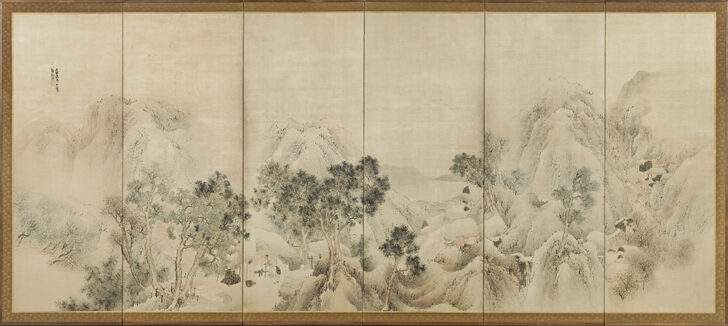Life in the Mountains
Matsumura Goshun

Description
Goshun was one of the founders of the Shijo school. Trained as a Nanga painter who took early Chinese paintings as models, he later followed the styles of Buson and Okyo, two of his contemporary masters. Goshun painted this pair of screens only a few months after he had moved to Ikeda while recovering from the shock caused by the deaths of his wife and his father. The screens took on new meaning to the artist when he abandoned life in the city for the countryside. The Michigan screens are the earliest known examples of screens on rural life by Goshun.
Subject Matter:
"Goshun painted these screens in the winter of 1781 only a few months after he had moved to Ikeda while recovering from the shock caused by the deaths of his wife and his father earlier in the year. Although Goshun had painted rural scenes before, they took on new meaning to him when he had abandoned life in Kyoto for the countryside. These are the earliest screens on rural life now known by Goshun. The others all bear the signature "Goshun" which he began to use in 1782. The Michigan screens are the closest to Buson'sstylein their reserved brushwork and comparatively short ts'un strokes in the hills. His later screens became progressively bolder in their approach. The screens in Berlin at the Museum fur Ostasiatche Kunst show the ts'un becoming longer and more prominent while in the later examples ts'un emerge as the dominant stylistic element of the painting. Some of these later examples, such as the screens at the Tokyo National Museum, treat this theme on a brilliant ground of gold leaf. and indicate Goshun's move from his close connection with Buson's style, as in the Michigan screens, to greater assurance in self-expression. This change presages his eventual abandonment of the reserved Nanga style in favor of the more immediate decorative appeal found in his Shijo period paintings."
"The great variety of foliage, figures, and dwellings seen in these screens present the full spectrum of Goshun's Nanga style. The rich pastel colors that glow from the silk harmonize with this idyllic portrayal of the virtues of rural life as conceived by the literati."
Adams, Celeste, and Paul Berry. Heart, Mountains, and Human Ways: Japanese Landscape and Figure Painting: a Loan Exhibition from the University of Michigan Museum of Art. Museum of Fine Arts, 1983.
Physical Description:
"The present screens present similar but separate landscape compositions. In the first panel on the right side, a path emerges and passes an empty roadside pavilion. Farther along, three men are strolling, two of them with hoes, as they return from work in the fields. Just ahead is a house where several people converse. Beyond is a valley with several homes and rice paddies. The scene ends with the path crossing over a small bridge by more rice paddies. These drained fields indicate that the season is early autumn after the rice has been harvested and the earth prepared for winter.
Goshun placed a figure on the far left of the second screen to draw the viewer into the composition from both directions. This man, glimpsed between trees, is wearing a backpack and carrying a large bag in his arms. He is approaching a group of shelters where a man is operating a device for threshing rice while another looks on. Outside are sheets of paper or cloth covered with grain. Under an awning is a large stack of carefully tied charcoal, and against the opposite side of the house is a collection of lumber. The path begins to rise into the mountains crossing two bridges and passing several dwellings. In the upper right corner of the left screen is a waterfall feeding into a small stream that runs by pavilions stacked with charcoal. The bare trees suggest approaching winter."
Adams, Celeste, and Paul Berry. Heart, Mountains, and Human Ways: Japanese Landscape and Figure Painting: a Loan Exhibition from the University of Michigan Museum of Art. Museum of Fine Arts, 1983.
Usage Rights:
If you are interested in using an image for a publication, please visit https://umma.umich.edu/request-image/ for more information and to fill out the online Image Rights and Reproductions Request Form.